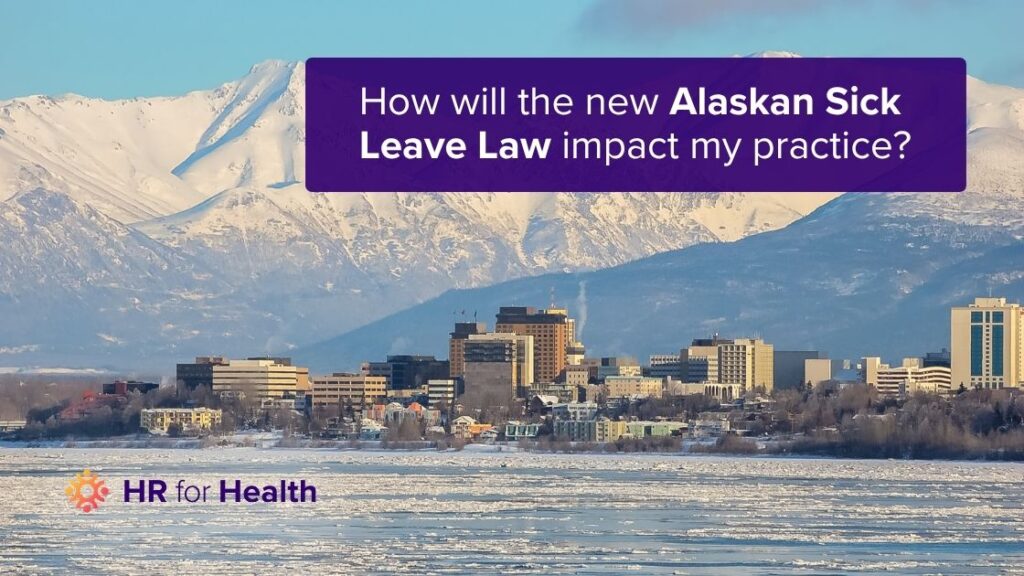Alaska’s employment landscape is evolving as the state considers implementing comprehensive sick leave legislation that would affect healthcare practices from Anchorage to the most remote villages. The Alaska paid sick leave law discussions reflect unique considerations for a state with challenging geography, seasonal employment patterns, and diverse healthcare delivery models. At HR for Health, we recognize the distinctive challenges Alaskan healthcare providers face and are committed to monitoring these legislative developments to help practices navigate the complex regulatory environment that may emerge.
Current Development of Alaska’s Sick Leave Legislation
Alaska approaches sick leave legislation differently than most states due to its unique economic and geographic characteristics. Paid sick leave laws in Alaska must account for remote work locations, seasonal employment cycles, and the logistical challenges of serving dispersed populations across vast distances.
Current legislative discussions in Alaska acknowledge that traditional sick leave models developed for urban, year-round employment may not translate directly to Alaska’s reality. Healthcare workers in Alaska often serve remote communities through fly-in arrangements, work extended rotations, or manage seasonal patient volume fluctuations that require flexible leave policies.
Key Provisions of the New Paid Sick Leave Law
Alaska’s sick leave requirements are now established through Ballot Measure 1, which passed in 2024 and takes effect July 1, 2025. The regulations create comprehensive frameworks that accommodate the state’s diverse employment landscape while maintaining consistent worker protections.
The accrual system requires employers to provide one hour of paid sick leave for every 30 hours worked, regardless of whether those hours are straight time, overtime, within different pay periods, or paid at different rates. This standardized approach applies to employees on alternative schedules, rotational schedules, or other non-traditional arrangements common in Alaska’s workforce.
Coverage thresholds reflect Alaska’s small business landscape through a tiered system based on employer size. Small employers with fewer than 15 employees must allow workers to accrue and use up to 40 hours of sick leave per year, while employers with 15 or more employees must provide up to 56 hours annually.
The legislation addresses Alaska’s unique employment situations by applying to nearly all workers, with specific exemptions for certain categories, including minors under 18 working less than 30 hours per week, apprentices with approved minimum wage exemptions, employees covered by collective bargaining agreements that expressly waive sick leave rights, and a few other non-healthcare related exceptions which can be reviewed here. Notably, the state of Alaska paying out sick leave does not require employers to pay out accrued sick leave upon termination, but if an employee is rehired within six months, their previous sick leave balance must be reinstated.
Preparing for Alaska’s Sick Leave Requirements
Healthcare practices in Alaska should begin preparing for potential sick leave legislation even as details remain under development. The unique aspects of paid sick leave laws in Alaska will likely require more complex preparation than standard employment law changes.
- Start by documenting your current leave policies and identifying how they align with emerging requirements. Alaska practices often have informal arrangements for handling employee illness that may need formalization under new legislation.
- Evaluate your ability to track employee hours and leave accrual across multiple locations or work arrangements. Alaska’s geography often requires healthcare workers to serve multiple communities, creating tracking challenges that require sophisticated systems.
- Consider how sick leave requirements might affect your ability to maintain coverage in remote or underserved areas. Developing contingency plans for employee illness in critical service areas helps ensure continuity of patient care while complying with leave requirements.
- Review your coordination with other healthcare providers for emergency coverage. Alaska’s healthcare system often relies on informal networks of providers who can assist during staffing emergencies, relationships that become more important under formal sick leave requirements.
Contact HR for Health To Stay Informed on Alaska Developments
As Alaska continues developing its approach to sick leave legislation, healthcare practices must stay informed about evolving requirements that will affect their operations. HR for Health specializes in helping healthcare practices navigate complex regulatory environments, through the use of technology and expert support. Our solutions adapt to unique state requirements while addressing the distinctive needs of healthcare providers in effectively and compliantly managing their team.Don’t wait for final legislation to begin preparing your Alaska practice for sick leave requirements. Contact us today to develop strategies that protect your practice while ensuring healthcare compliance with emerging Alaska employment regulations in the challenging but rewarding environment of Alaskan healthcare delivery.


